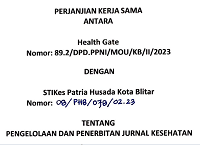The Effect Of Delaying Umbilical Cord Cutting On Hemoglobin Levels In Newborn Babies
Abstract
Abstract
Iron deficiency anemia, commonly occurring in infants aged 6-24 months, can be prevented by delaying the cutting of the umbilical cord after birth. A quasi-experimental study conducted at the Mother and Child Clinic in Mojo Kediri involved 30 infants, divided into an experimental group (with delayed cord clamping) and a control group. Hemoglobin levels were measured using a Hematology Autoanalyzer, and the data were analyzed using a t-test. The intervention group, with a delay in cord clamping for 1 hour, showed an average increase in Hb levels from 15.444 g/dl to 19.800 g/dl after 24 hours. Meanwhile, the control group, without any delay, increased from 15.544 g/dl to 16.844 g/dl. Delaying the umbilical cord clamping significantly increased hemoglobin levels in newborns (p-value: 0.000). Infants with delayed cord clamping exhibited higher hemoglobin levels, better body iron reserves, and reduced risk of anemia. The higher red blood cell levels supported better cardiopulmonary adaptation and increased breastfeeding duration in early life. The research concludes that delaying the cutting of the umbilical cord for 2 minutes in newborns can enhance Hb levels after 24 hours compared to cord clamping at 15 seconds after birth. This highlights the importance of delaying cord clamping to support hemoglobin health and infant development.
Keywords: Delaying Umbilical Cord Clamping, Hemoglobin Levels, Newborns
Full Text:
PDFReferences
REFFERENCE
Abalos et al. (2020). Utility of Gastroscopy at The Time of Colonoscopy in Patients With Iron-Deficiency Anemia Referred to A Colorectal Cancer Detection Program. Endoscopy, 51(4), 28.
Artha, D. (2020). Gambaran hasil peningkatan kadar hemoglobin pada pasien anemia yang ditransfusi dengan packed red cell dan whole blood di rsud kabupaten polewali mandar 1. 10(November).
Gupta R. dan Ramji S. (2019). Effect Of Delayed Cord Clamping On Iron Stores In Infants Born To Anemic Mothers: A Randomized Controlled Trial. Indian Pediatrics, 39, 130–135.
Mercer, K. (2018). Evaluation of anemia in communities ser aluation of anemia in communities served by Shoulder t y Shoulder to Shoulder Global: A Cross-Sectional Study in Santo Domingo, Ecuador. Literati Imprint dari Penerbit Lentera Hati.
Nurrochmi, E., Hapitria, P., & Suhaemi, C. (2018). Perbedaan Kadar Hemoglobin Pada Bayi Baru Lahir Yang Dilakukan Penundaan Pemotongan Tali Pusat Dengan Yang Segera Dipotong Pada Persalinan Normal Di RSUD Gunung Jati Kota Cirebon Periode Februari-Maret 2018. Jurnal Ilmiah Ilmu Kesehatan, 2(3), 7–16.
Sembiring, K., Lubis, B., Rosdiana, N., Nafianti, S., & Siregar, O. R. (2018). Status Imunitas Anak dengan Anemia Defisiensi Besi. Cermin Dunia Kedokteran, 45(9), 653–655.
Wang, M. (2016). Iron Deficiency and Other Types of Anemia in Infants and Children. American Family Physician, 93(4), 270–278. www.aafp.org/afp.%0Ahttps://www.google.com.ec/_/chrome/newtab?espv=2&ie=UTF-8
DOI: https://doi.org/10.70111/hg2304
Refbacks
- There are currently no refbacks.
"Health Gate"
ISSN 2986-1098
Indexing:
Published by The Regional Leadership Council of the Indonesian National Nurses Association, Blitar City
Kalimantan Street, Kel.Karangtengah, Kec. Sananwetan, Blitar City, East Java, Indonesia


.png)








